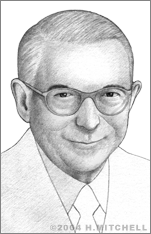Ole Christiansen
In the first half of the 20th century, Danish carpenter Ole Kirk Christiansen created one of the most beloved toys of all time, enjoyed all over the world by millions of children and quite a few adults as well. Those toys are the building blocks known as LEGOs.
Christiansen was born in 1891 in Filskov, Denmark, a small village north of the Danish town of Billund. He was educated up until high school, and then began working in a factory, eventually becoming a woodworker and master carpenter. He set up his own business in Billund in 1932. Among the products he made were stepladders, ironing boards, and wooden toys – which would become his specialty. Toys, especially wooden blocks, were, in fact, the business’s most successful product. In 1934, the company adopted the name “LEGO,” from the Danish words “Leg Godt,” or “play well.” (Appropriately, “Lego” also means “I study” or “I put together” in Latin).
In 1944, Christiansen’s factory burned down, but he rebuilt it in 1947 and picked up where he left off. This time, however, his business was dedicated to creating toys. The company became the first in Denmark to buy a plastic molding machine. By 1949, it was producing some 200 different wooden and plastic toys. LEGO’s Automatic Binding Bricks, however, were still made of wood at that time, and they were available only in Denmark. They became very popular there, but they really took off once Christiansen began making them out of brightly colored plastic.
Christiansen’s son, Godtfred Kirk Christiansen, had begun working alongside his father in 1942. In 1950, he was named Junior Vice President of the company. It was he who conceived of the idea of developing Lego blocks into a total “system of play.” By 1953, LEGO started marketing complete plastic block sets, and in 1954, they obtained a trademark for the product, which they renamed "LEGO Mursten" or "LEGO Bricks."
The company officially launched the “LEGO System of Play” in 1955, which comprised 28 different sets and eight toy vehicles. LEGO patented the bricks’ “stud-and-tube coupling system” in 1958. That year, founder Christiansen died. His son Godtfred immediately took the LEGO helm.
Legos continued to gain popularity, with more themed toy sets and building-block variations added all the time. The first LEGO sets were sold in the United States in 1961. By 1966, offerings included bricks that could form all sorts of buildings, vehicles, and backdrops. A larger version of the blocks, named DUPLO, was added in 1967 and was designed for younger children and toddlers. In 1977, LEGO introduced TECHNIC projects for older kids and teens. Over the years, the company added all sorts of themed Lego sets, even robotic building sets branded LEGO Mindstorms, model vehicle kits, and computer games.
Additionally, LEGO opened a series of theme parks based on the Lego toy concept, the first in Billund in 1968. Others opened in Windsor, England in 1996 and in Carlsbad, California in 1999. A fourth park opened in 2002 in Gunzburg, Germany. The parks continue to be immensely popular with people of all ages, especially parents and their children.
Ole’s grandson, Kjeld Kirk Kristiansen, later became CEO of the company and maintained that position until October 2004 when he was replaced by the company’s first non-family chief executive. LEGO has been a pioneer in using its products to advance research in learning and play. Initiatives include the LEGO Learning Institute, the LEGO Educational Division, collaboration with MIT’s Media Lab, and LEGO Serious Play, a product designed to help business owners to develop innovative strategies and solutions. The company has sold LEGO toys in more than 130 countries.


